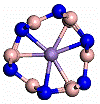Department of Physics and Astronomy: Publications and Other Research

Stephen Ducharme Publications
Document Type
Article
Date of this Version
2011
Abstract
The embedding of oxide nanoparticles in polymer matrices produces a greatly enhanced dielectric response by combining the high dielectric strength and low loss of suitable host polymers with the high electric polarizability of nanoparticles. The fabrication of oxide–polymer nanocomposites with well-controlled distributions of nanoparticles is, however, challenging due to the thermodynamic and kinetic barriers between the polymer matrix and nanoparticle fillers. In the present study, monodisperse TiO2 nanoparticles having an average particle size of 14.4 nm and predominant rutile phase were produced using a cluster-deposition technique without high-temperature thermal annealing and subsequently coated with uniform vinylidene fluoride oligomer (VDFO) molecules using a thermal evaporation source, prior to deposition as TiO2–VDFO nanocomposite films on suitable substrates. The molecular coatings on TiO2 nanoparticles serve two purposes, namely to prevent the TiO2 nanoparticles from contacting each other and to couple the nanoparticle polarization to the matrix. Parallel-plate capacitors made of TiO2–VDFO nanocomposite film as the dielectric exhibit minimum dielectric dispersion and low dielectric loss. Dielectric measurements also show an enhanced effective dielectric constant in TiO2–VDFO nanocomposites as compared to that of pure VDFO. This study demonstrates for the first time a unique electroactive particle coating in the form of a ferroelectric VDFO that has high-temperature stability as compared to conventionally used polymers for fabricating dielectric oxide–polymer nanocomposites.


Comments
Published in Nanotechnology 22 (2011) 405605 (8pp); doi:10.1088/0957-4484/22/40/405605 © 2011 IOP Publishing Ltd. Used by permission.